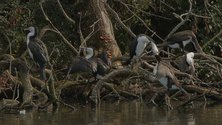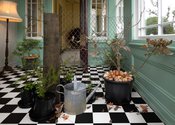John Hurrell – 18 May, 2023
The uniting thread is the meandering Colonial Road in Birkenhead that winds its way down to the stagnant reservoir next to the Chelsea Sugar Refinery. In particular, the shag colony (with three types of shag) living in the oak trees at the edge of the deoxygenated lake.
Auckland
A.A.M. Bos, Carole Prentice, Dr P
Colonial Road
20 April - 2 July 2023 (Bos & Prentice)
20 April - 14 May (Dr P)
Three Mokopōpaki artists (A.A.M. Bos, Carole Prentice, Dr P) feature in three spatially separated, Pah Homestead galleries. All quite different, but with a connecting thread that is carefully explained in the very thorough exhibition catalogue.
That thread is the meandering Colonial Road in Birkenhead that winds its way down to the stagnant reservoir next to the Chelsea Sugar Refinery. In particular, the shag colony (with three types of shag) living in the oak trees at the edge of the deoxygenated lake.
In the colonial homestead’s upstairs AV Gallery, A.A.M. Bos presents a fascinating twenty minute film examining the feeding habits, courtship rituals, nest building, and chick raising routines of the shags, as well as visually elucidating the spatial relationship of the colony to Colonial Rd, the Auckland Harbour Bridge and the Chelsea factory buildings— while featuring Elgar’s Pomp and Circumstance march and part of Serenade for Strings in E Minor Opus 20 as a movie soundtrack.
The sequences with ornithological content are related to the photographic work of fellow New Zealander Richard Frater, with his keen studies of bird life in Germany; but with a different kind of political focus, more layered and about the history of colonialism, being symbolic and less overtly ecological.
In Dr P’s installation in the Conservatory, an ornate mahogany chiffonier presents the remnants of a seafood breakfast for a family of Birkenhead shags, with a wall switch for a nearby poster of Magritte‘s Empire of Light to aid a tall freestanding lamp for early morning illumination. ‘Illumination’ is the Doctor’s code word for wisdom, particularly when referencing natural resources.
Instead of the white sauce that Belgians like Magritte and Broodthaers are used to (particularly the latter with his billy of mussels), Dr P presents a plate of stale white buns alongside a bottle of HP British brown sauce to accompany the (now devoured) mussels, a colander of shelled cockles, and platters and silver trays of oyster shells and smoked fish skeletons. And hen’s eggs too, the shells of which are found with the planted shrubs. This mix is in keeping with the plants Dr P has positioned in the conservatory, that include not only an oak, but also a tōtara, a pōhutukawa and a kōwhai.
Carole Prentice’s father worked for the Chelsea Sugar Works, and so that institution was an important part of her childhood. Her display in the upstairs Little Gallery, close to the AV Gallery, presents a mixture of paintings and laminated translucent collages in a manner vaguely similar to Merylyn Tweedie. Empty trademarked paper bags once used for conveying Chelsea sugar are blended with drawn magazine images or family snaps of innocent young white girls on swings or steps, having a happy childhood, surrounded by shelves of sickly sugary confectionary.
The paintings are larger and more ominous. They exude a very different mood, being largely grey and black, sinister and apocalyptic. One has an image of what seems to be a disillusioned looming Christ climbing up out of the Birkenhead landscape. Actually it is James K. Baxter. Another has a smaller version of Baxter emerging from the swampy lake. Polluting ‘dark Satanic mills’ figure prominently in the backgrounds of both. Both contain empty white armchairs, past symbols of colonial exploitation and privilege.
One square colour-rich painting has a shag in a tree fighting a fierce taniwha, and a floating Māori God stick features in one of the lake paintings. These are possibly a reference to sovereignty disputes, or clashing religious / cultural ideologies. There is also a very subtle allusion on the bottom of one grey painting to the harvesting of Queensland canefields that Chelsea sugar came from, the hideous ‘blackbirding’ of South Pacific Islands, and the cruel indenture system.
This is an excellent grouping of thoughtful presentations that resonate together superbly. Well worth an excursion to Monte Cecilia Park.
John Hurrell


















 Advertising in this column
Advertising in this column Two Rooms presents a program of residencies and projects
Two Rooms presents a program of residencies and projects



This Discussion has 0 comments.
Comment
Participate
Register to Participate.
Sign in
Sign in to an existing account.